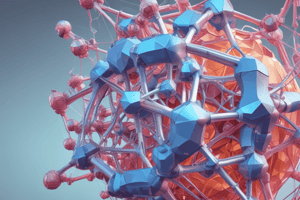Podcast
Questions and Answers
What are the seven crystal systems?
What are the seven crystal systems?
Triclinic, Monoclinic, Orthorhombic, Tetragonal, Cubic, Rhombohedral (Hexagonal), Hexagonal
How many distinct Bravais lattices are there?
How many distinct Bravais lattices are there?
14
What crystal system has all unit cell edges equal and angles between them at 90°?
What crystal system has all unit cell edges equal and angles between them at 90°?
Cubic
Which crystal structure is commonly found in transition metals and their compounds?
Which crystal structure is commonly found in transition metals and their compounds?
What role do crystal structures play in technology development?
What role do crystal structures play in technology development?
How many crystal classes are there based on the combinations of crystal systems, unit cell systems, and rotation axes?
How many crystal classes are there based on the combinations of crystal systems, unit cell systems, and rotation axes?
What is a crystal lattice?
What is a crystal lattice?
How is a simple cubic (SC) crystal lattice characterized?
How is a simple cubic (SC) crystal lattice characterized?
Describe the body-centered cubic (BCC) crystal lattice.
Describe the body-centered cubic (BCC) crystal lattice.
What are the characteristics of a face-centered cubic (FCC) lattice?
What are the characteristics of a face-centered cubic (FCC) lattice?
What is a Bravais lattice?
What is a Bravais lattice?
How do crystal lattices contribute to the physical and chemical properties of solids?
How do crystal lattices contribute to the physical and chemical properties of solids?
Flashcards are hidden until you start studying
Study Notes
Exploring Solid State: Crystal Structures at a Glance
Solid state, a fundamental state of matter, is characterized by the close-packed arrangement of atoms, ions, or molecules in a rigid, ordered, and repeating crystalline form. This organization gives rise to unique physical and chemical properties, making it a cornerstone for essential technology and scientific understanding. Let's delve into the crystal structures that lie at the heart of the solid state.
Crystal Lattices
A crystal lattice is a three-dimensional array of repeating unit cells that form the foundation of a solid's crystal structure. These unit cells are building blocks that determine the macroscopic properties of a material.
Examples of common crystal lattices include:
- Simple cubic (SC): Each lattice point has 6 nearest neighbors.
- Body-centered cubic (BCC): Each lattice point shares corners with 8 nearest neighbors, and there is an additional lattice point at the center of the cube.
- Face-centered cubic (FCC): Each lattice point shares corners with 12 nearest neighbors, and there are additional lattice points at the center of each face.
Bravais Lattices
The Bravais lattice is a specific type of crystal lattice that is translated by its unit cell vectors to create a space-filling pattern. There are 14 distinct Bravais lattices, which can be categorized into seven unique types: simple cubic, body-centered cubic, face-centered cubic, simple hexagonal, body-centered hexagonal, face-centered tetragonal, and body-centered tetragonal.
Crystal Systems
Crystal systems describe the geometric relationships of the unit cell's edges and faces. There are seven crystal systems:
- Triclinic: Unit cell edges, and the angles between them, are all different.
- Monoclinic: Two unit cell edges are equal, and one angle between them is 90°.
- Orthorhombic: All three unit cell edges are equal, but the angles between them are not 90°.
- Tetragonal: Two unit cell edges are equal, and the angles between them are both 90°.
- Cubic: All unit cell edges are equal, and all angles between them are 90°.
- Rhombohedral (hexagonal): Three unit cell edges are equal, and the angles between them are all equal and not 90°.
- Hexagonal: Unit cell has two sets of edges that are equal, while the third is shorter and makes an angle of 120° with the others.
Crystal Symmetry
Crystal symmetry refers to the arrangement of atoms, ions, or molecules within the unit cell and the repeating lattice. There are 32 distinct crystal classes, which are combinations of the seven crystal systems, five unit cell systems, and the three types of rotation axes (1, 2, and 3). These classes help to describe the symmetry of a crystal structure.
Periodic Table and Crystal Structures
The periodic table is a useful tool to understand the variety of crystalline structures that can occur with different elements. Transition metals and their compounds often form face-centered cubic (FCC) structures, while alkali metals and halogens typically have a body-centered cubic (BCC) arrangement.
Applications of Crystal Structures
Crystal structures play a crucial role in the development of various technologies such as semiconductors, batteries, solar cells, and many more. Understanding these structures aids in optimizing materials for specific applications and developing new materials with tailored properties.
In summary, crystal structures are the foundation of the solid state, and understanding them is essential for a deeper appreciation of physical and chemical properties. The geometric arrangement of unit cells in lattices, Bravais lattices, and crystal systems helps to describe and classify these structures. The periodic table and crystal symmetry provide valuable insights into the behavior of elements and their compounds in the solid state. Finally, knowledge of crystal structures is integral to the development of new materials and technology.
Studying That Suits You
Use AI to generate personalized quizzes and flashcards to suit your learning preferences.




